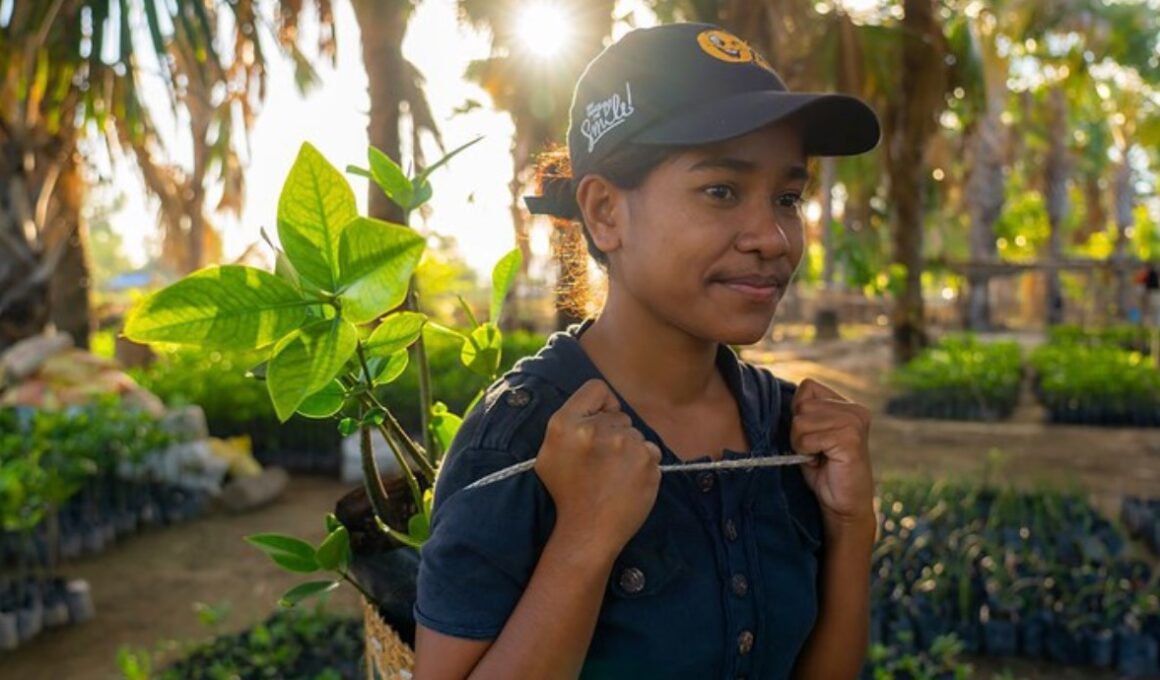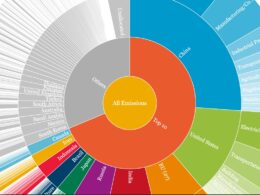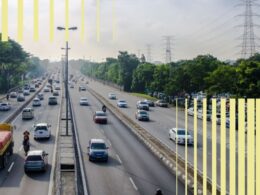Vulnerable countries are stepping up and taking climate action, amid a slow response from some of the biggest emitters of carbon dioxide.
United Nations
Climate and Environment
28 October 2021
Communities in Timor-Leste are helping to restore mangrove forests.
In a new analysis, released ahead of the COP26 climate negotiations, the agency said that 93 per cent of least developed countries (LDCs) and small island developing States (SIDS) have submitted enhanced national climate plans ( NDCs), or plan to do so.
On the other hand, UNDP says, some countries in the G20 bloc of leading industrialized countries have been “dragging their feet on adhering to the core principles of the Paris Agreement to ‘ratchet up’ their climate ambition.”
The G20, meeting in Rome this weekend, is responsible for more than three-quarters of global greenhouse gas emissions.
Deadlines missed
Three G20 members submitted new pledges in just the past few days, missing a deadline of 12 October for inclusion in analysis of the UN Framework Convention on Climate Change ( UNFCCC).
In addition, of the 18 NDCs that have now been submitted, many rely on long-term targets and lack the meaningful near-term ambition needed, said UNDP.
Looking only at intentions to reduce emissions, 86% of LDCs and SIDS, intend to raise mitigation ambition, up from 40% in 2019. The agency also notes that, ultimately, this group of 78 countries is only responsible for 7% of global emissions.
For the UNDP Administrator, Achim Steiner, “these figures demonstrate that many developing countries across the world are leading the way for decisive climate action.”
“COP26 must be the moment where all nations rise to the challenge of climate change, especially high-emitters. As the window to limit global warming to 1.5 degrees Celsius narrows, this is our only pathway to secure the future of people and planet”, he said.
Encouraging news
The report also highlights some encouraging news.
For example, the Paris Agreement’s ratchet mechanism is working, with most countries following the key requirement to revise and submit increasingly ambitious NDCs, every five years.
In total, 178 countries representing 79.3% of global emissions, plan to submit enhanced NDCs. In 2019, only 75 countries did so. Of this group, 160 countries have strengthened their targets.
UNDP also notes an uptick since 2019 in the number of countries preparing and submitting long-term strategies to reach net-zero emissions by mid-century.
Saudi Arabia, for example, announced earlier this week a 2060 net zero target. This Thursday, Australia and China confirmed net zero targets for 2050 and before 2060, respectively.
For the President of the UN General Assembly, Abdulla Shahid, this news offers “a slightly more hopeful view.”
“While the report acknowledges the gaps, particularly around financing, and commitments from wealthier countries, there is nonetheless cause for cautious optimism”, he said.
Originally published at https://news.un.org on October 28, 2021.
ORIGINAL PUBLICATION
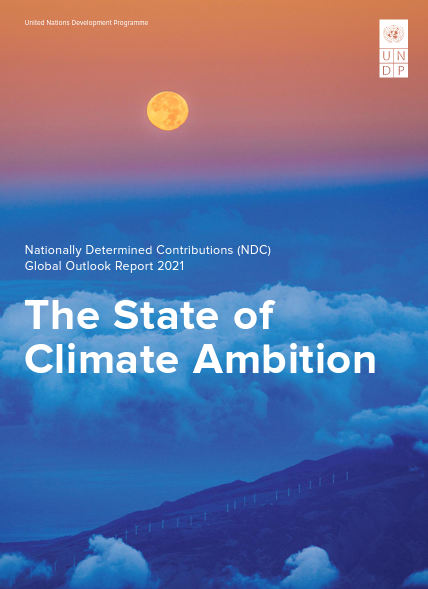
The State of Climate Ambition
United Nations
Editor Florence Marchal
His Excellency Mr. Abdulla Shahid, President of the 76th Session of the United Nations General Assembly;
Mr. Achim Steiner, UNDP Administrator
This is an excerpt from the report above, focusing on the EXECUTIVE SUMMARY.
Executive Summary
Against a backdrop of increasing scientific concern and public awareness about the climate crisis, UNDP set out to review if policymakers were keeping the promises they made in 2019 when the global state of climate ambition was assessed with UNFCCC in the first NDC Global Outlook report, The Heat is On.
We were curious. Is the Paris Agreement working? And if yes, then who is doing the work? Which countries are leading the way on ambition — and which ones are falling behind?
UNDP had also launched the Climate Promise initiative at the UN Climate Ambition Summit in September 2019 as a commitment to ensuring that lack of funds and/or capacity would not be a barrier for any developing country that wished to prepare a more ambitious national climate pledge, or NDC.
The Climate Promise quickly became the world’s largest offer of support to countries for the NDC revision process.
At that time, there was no warning that the world would soon be facing a global health pandemic and that UN climate negotiations would be postponed a full year to November 2021 in Glasgow.
But even as countries began to indicate that they would miss the original UNFCCC deadline of December 2020 for submission of so-called “second-generation” NDCs, the intentions of Climate Promise countries to submit more ambitious climate pledges kept growing.
The key findings presented here unpack the concept of “ambition” against reality on the ground, drawing upon UNDP analysis and experience in Climate Promise countries.
- Do higher-quality NDCs result in more ambition?
- Do more inclusive approaches to NDC revision lead to greater ambition?
- Did the COVID-19 pandemic impact countries’ intentions?
- And what opportunities emerging to accelerate NDC implementation?
For more information on the analytic approach used, please refer to the Methodology.
Key messages (Added by the Editor of the blog)
- The Paris Agreement’s “ratchet mechanism” is working … On the surface, the overall global trend of climate ambition appears promising.
- NDC submissions are strongly aligned to UNFCCC deadlines.
- but the world needs even greater ambition and faster action
- Climate ambition is nuanced and context specific.
The Paris Agreement’s “ratchet mechanism” is working … On the surface, the overall global trend of climate ambition appears promising.
A key principle of the Paris Agreement adopted in 2015 was that nations would “ratchet up” their efforts to combat climate change every five years. The aim is to demonstrate a progression beyond the previous pledge, and to reflect a country’s “highest possible ambition.”
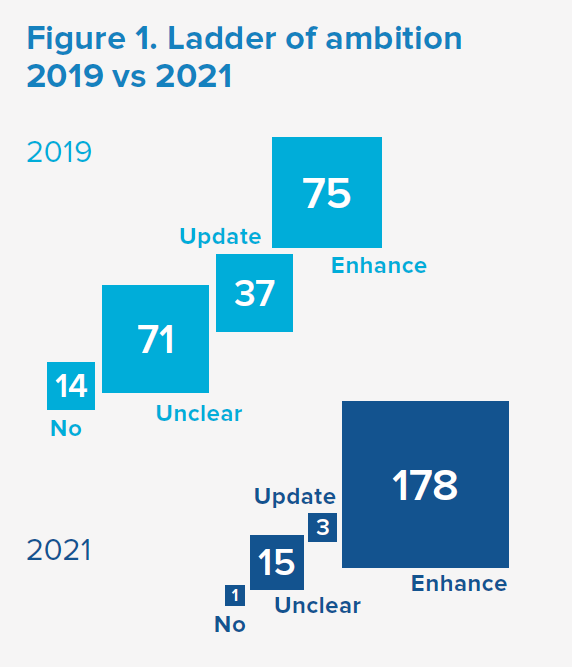
Figure 1 compares global ambition intentions in 2019 to 2021. The number of countries intending to enhance their NDCs — either by increasing their GHG emission reduction targets and/or by strengthening their adaptation goals — rose from 75 countries in 2019 to 178 in 2021. In 2019, 37 countries planned to update without raising ambition — ultimately, only three have done so. The unclear and/or no information category fell from 71 countries in 2019 to 15 in 2021, showing that even amidst one of the most devastating global health crises, countries continued to define their climate pledges. Finally, the number of countries with no intention to submit currently stands at only one, compared to 14 in 2019, many of which included some of the world’s major emitters.
Another positive trend is the increasing ratification of the Paris Agreement:
Angola, Kyrgyzstan, and Lebanon ratified the Paris Agreement in 2020 and South Sudan and Turkey in 2021, while Iraq is well-advanced towards that aim.
This leaves only four countries out of 197 still pending: Eritrea, Iran, Libya, and Yemen. For all UNFCCC ratification dates, see here.
NDC submissions are strongly aligned to UNFCCC deadlines.
The COVID-19 health pandemic left most countries grappling with the timing of their NDC submissions, as government priorities shifted to minimizing the economic fall-out and human impact of a world in lockdown.
Despite this major challenge, as of 12 October 2021, 143 countries had submitted second-generation NDCs to the UNFCCC (including four interim NDCs) — a significant increase from the two that had submitted by September 2019. It is anticipated that 38 more countries will submit NDCs by the end of 2021, with the majority still aiming to do so by the COP26 negotiations in Glasgow in November. As shown in Figure 3, this would bring the total number of submitted second-generation NDCs to 181 — representing 92% of all Parties to the Paris Agreement.
The timing of NDC submissions aligns strongly with deadlines established by the UNFCCC for inclusion of NDCs in the NDC synthesis report. At the end of 2019, four countries had submitted second-generation NDCs, but by December 2020 — which was when COP26 was initially expected to take place — 67 more countries had made submissions, of which 84% were submitted in Q4. Similarly, in 2021, 40 countries submitted NDCs (excluding interim submissions) by the UNFCCC deadline of 30 July for inclusion in its synthesis report and an additional 32 countries made a 12 October deadline to be included in an update to the report.
… but the world needs even greater ambition and faster action
The updated ladder of ambition for 2021 (Figure 2) shows the potential significance of having 90% of the world submitting, or planning to submit enhanced NDCs to the UNFCCC. In total, these 178 nations are responsible for nearly 80% of global GHG emissions. Figure 2 unpacks country intentions further by examining whether these 178 countries are pledging to raise mitigation ambition — that is, are outlining commitments in their NDCs to curb their emissions of the GHGs that cause global warming — or more focused on ramping up their plans to adapt and become more resilient to climate impacts. As shown, 90% have raised mitigation ambition, or plan to do so, while 97% are incorporating stronger adaptation goals. A small subset have focused solely on strengthening either mitigation or adaptation plans, but not both.
Figure 2 also shows that the three countries that are updating their climate pledges but not raising ambition represent only 4.3% of global GHG emissions.
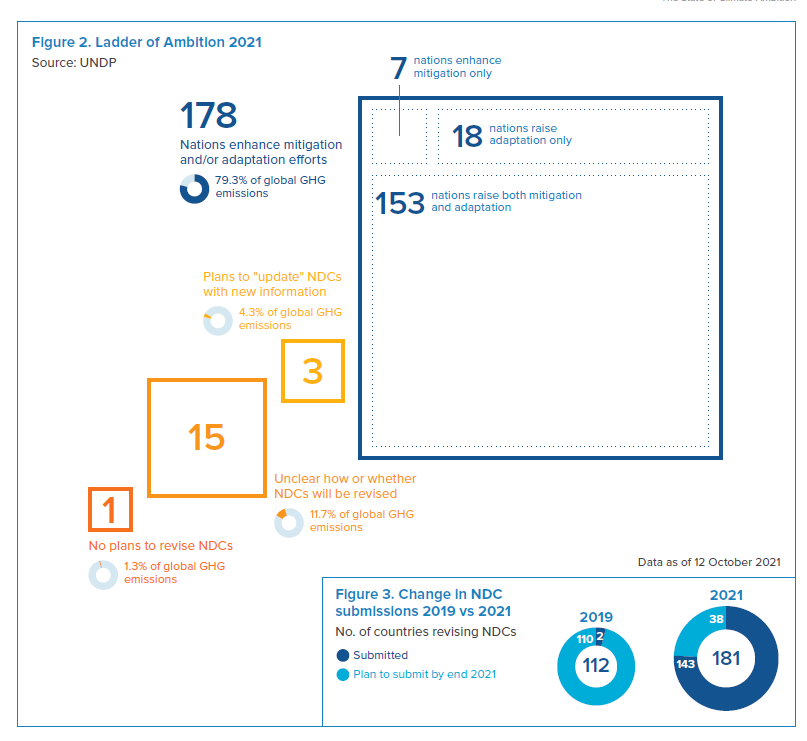
As of 12 October, only one higher-emitting country had not signalled any clear plans to submit an enhanced NDC. For the remaining 15 countries where intentions are unclear, or no information is currently available (representing 11.7% of global GHG emissions), there is still a possibility that more ambitious NDCs could be put forward.
Nonetheless, despite this progress the latest analyses of NDCs reveals that much greater ambition is needed across the board. The UNFCCC (2021) reports that global emissions will be 16% higher in 2030 than they were in 2010 based on current climate pledges — far from the 45% reduction by 2030 needed to limit warming to 1.5°C. UNEP (2021) similarly acknowledges that while countries show some progress in their new climate pledges, the aggregate effect on global emissions is disappointing.
Climate ambition is nuanced and context specific.
However, beneath the surface of these promising trends lies a more nuanced picture of climate ambition. This report dives into what ambition looks like through the lens of countries’ NDCs and the revision processes that defined them.
Specifically, we find that:
- Vulnerable nations are leading on NDC ambition — the role expected from the G20;
- Second-generation NDCs are higher quality, but finance remains a hurdle;
- For many countries — but not all — inclusivity drives ambition;
NDCs can provide a blueprint for sustainable development and green recovery, but countries must lock in this pathway now.
This report makes clear that higher-quality NDCs and more inclusive processes are underpinning ambition goals, but developing countries still require significant support to deliver on their targets. Finance remains a fundamental barrier to NDC ambition and acceleration of climate action in developing countries. Developed economies must therefore address their financial obligations in this context, while the G20 must show much greater leadership by acting urgently and boldly on climate action if the world is to have any hope of achieving the Paris Agreement’s global goals. Finally, truly transformational change does not happen without change-makers; those most impacted by the climate crisis — and by climate solutions – must have a seat at the table.
Foreward
Climate change is the greatest challenge of our time: a crosscutting, multidimensional threat multiplier. The most recent Intergovernmental Panel on Climate Change (IPCC) report confirms that climate change is now rapid, intensifying, and widespread. The United Nations Children’s Fund’s (UNICEF) first children’s climate risk index estimates that roughly one billion children — nearly half the world’s 2.2 billion children — live in countries extremely vulnerable to climate change’s impacts. Cumulatively, this signals a moment of reckoning for humanity.
We are in the race of our lives, with only days remaining until new climate talks begin under the United Nations Framework Convention on Climate Change (UNFCCC) 26th Conference of the Parties (COP26). We must secure consensus from all countries to keep the 1.5-degree Celsius (°C) goal within reach and we must also ensure adequate support is in place for all countries to respond to growing climate impacts, ultimately to maintain hope in our shared future on our blue planet.
It is heartening to see in this report that there is a recognition of the climate crisis. The majority of countries are doing their part. Multilateralism is working. The Paris Agreement’s ratchet mechanism is working — even though there is much more that we must do.
The COVID-19 pandemic has however overwhelmed States’ capacities, just when they were needed most to address our climate priorities. Without global solidarity and innovative solutions to tackle COVID-19’s impacts, all countries risk losing hard-won development gains, as well as losing the chance to develop the capacities needed to urgently act for our planet’s climate health.
While the UNFCCC is the primary international, intergovernmental forum for negotiating the global response to climate change, the United Nations General Assembly has a critical role in creating a space to foster political consensus, raise awareness, give strategic direction to the United Nations system and forge multi-sectoral partnerships among the broader global community for the scale and breadth of ambition needed to secure humanity’s future.
Therefore, we find much that is useful in this report in terms of where we need to direct our energies. The report shows that one area where we can all improve is ensuring that just transition efforts are the centrepiece of climate action. We will not achieve the transformational change required unless we have the buy-in of the private sector and workers.
The report demonstrates that countries have made deliberate and concerted efforts to engage policymakers, the private sector and citizens through whole-of-government and whole-of-society approaches. It is also pleasing to note the efforts being made to reach out to youth, who are rapidly becoming disaffected by our climate inaction.
The report makes clear — as we have always known — that finance remains a hurdle for climate ambition. But this barrier can be easily resolved if we recognise and treat climate change as the crisis that it is.
A loss of hope in climate action is at an all-time high globally, especially among youth. A sustained sense of despair, leading to public apathy and inaction, would not augur well for humanity’s future, especially at this turning point that will determine our future for the decades to come.
This report recognizes that there is broad commitment to the notion of planet, prosperity and people, but now we need the political will for a transformational climate action that will create the pathway for a cleaner, greener and bluer planet.
His Excellency Mr. Abdulla Shahid, President of the 76th Session of the United Nations General Assembly;
Foreword 2
In 2019, the United Nations Development Programme (UNDP) and the UNFCCC) set out to examine the world’s intended level of ambition for tackling climate change.
The resulting report, The Heat Is On, stated that 2020 would be a pivotal year to galvanise support for bold climate action so that greater ambition would be locked-in as quickly as possible.
“In order to reach net-zero carbon dioxide (CO2) emissions by 2050, decisions need to be taken and enacted within the next two years,” it argued.
This 2021 NDC Global Outlook report examines how far the world has progressed on this climate ambition.
Despite many challenges, it demonstrates that there are many reasons to be hopeful for the future.
The number of countries that have enhanced their Nationally Determined Contributions (NDCs) or intend to do so — by strengthening greenhouse gas emission reduction targets and/or adaptation goals — rose from 75 countries in 2019 to 178 in 2021.
And most countries have abided by the key principle to submit increasingly ambitious NDCs every five years.
The Paris Agreement’s “ratchet mechanism” is working. UNDP has been the heartbeat of the NDC enhancement process in developing countries across the world. In 2019, it made an ambitious pledge to support at least 100 countries to enhance their NDCs through our Climate Promise. In 2021, 120 countries and 35 partners are now part of the Climate Promise, the world’s largest offer of its kind.
As a result of this support, governments are taking increasingly bold steps to decarbonize and take decisive climate action.
Indeed, the COVID-19 pandemic has prompted a radical re-think of deeply ingrained approaches.
Consider Lao PDR, for instance, which is using its NDC to create a circular economy that will help to “design out” pollution and shape a low-carbon future.
Countries such as Nigeria, Tunisia, Serbia, Chile, and Indonesia are promoting closer linkages between COVID-19 recovery and climate ambition.
Over 70 countries are leveraging their enhanced NDCs to un-lock new investments in key areas like health, education, clean energy, food and agriculture and nature.
And countries are using the NDC revision process to innovate. Ecuador, Honduras, and Paraguay are exploring carbon market opportunities for the forest sector, for example.
The next phase of the Climate Promise, From Pledge to Impact, will increase our support to countries to accelerate the implementation of their NDCs.
That involves boosting the connection between NDCs, sustainable development plans, and credible net-zero pathways.
UNDP will also continue to innovate and explore, using tools like the Peoples’ Climate Vote to engage more people on climate solutions.
And we will scale-up our ability to share solutions amongst countries to drive forward an equitable and just transition.
On behalf of UNDP, I would like to express my sincere gratitude to the NDC Partnership and its implementing partners, our UN partners including UNFCCC, the UN Environment Programme (UNEP), the Food and Agriculture Organization (FAO) and the International Labour Organization (ILO), as well as the International Renewable Energy Agency (IRENA).
I would also like to thank the European Union, Germany, Sweden, Spain, and Italy — early investors in this work — alongside emerging partners including Belgium and Iceland, as well as UNDP’s core financing partners who make this work possible.
The initiatives and solutions detailed in the 2021 NDC Global Outlook report demonstrate that countries and communities across the globe are now taking up the baton for decisive climate action.
With the Sustainable Development Goals helping to guide us out of this climate crisis, the entire UN family and its partners will continue to offer the level of support that is needed at this crossroads for people and planet.
Mr. Achim Steiner, UNDP Administrator
This report was developed under UNDP’s Climate Promise as a contribution to the NDC Partnership, with funding from the governments of Germany, Sweden, Spain, Italy, the European Union, and all UNDP’s core contributors (Germany, United States, Japan, Unit-ed Kingdom, Sweden, Norway, Switzerland, Canada, Denmark, Netherlands, Belgium, France, Australia, Ireland, Qatar, Republic of Korea, Italy, New Zealand, India, China, Lux-embourg, Finland, Saudi Arabia, Turkey, Austria, Russian Federation, Thailand, Bangla-desh, United Arab Emirates, Kuwait, Singapore, Estonia, Czech Republic, Israel, Iceland, Indonesia, Portugal, Liechtenstein, Mongolia, Latvia, Andorra, Cambodia, Iran, Pakistan, Cuba, Antigua and Barbuda, Philippines, Myanmar, and Albania).
Originally published at http://climatepromise.undp.org




